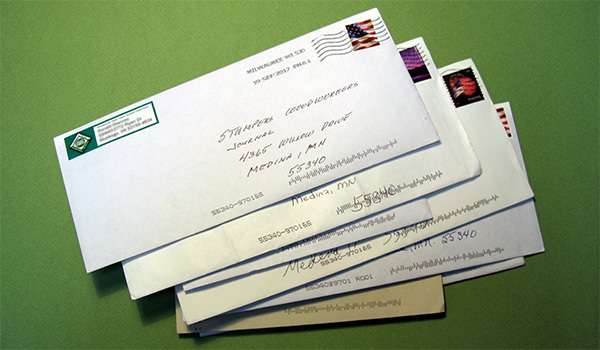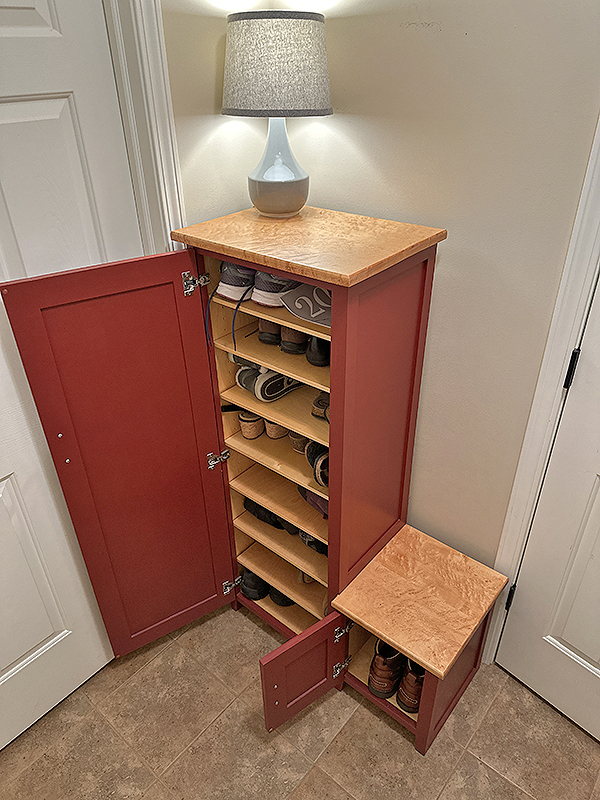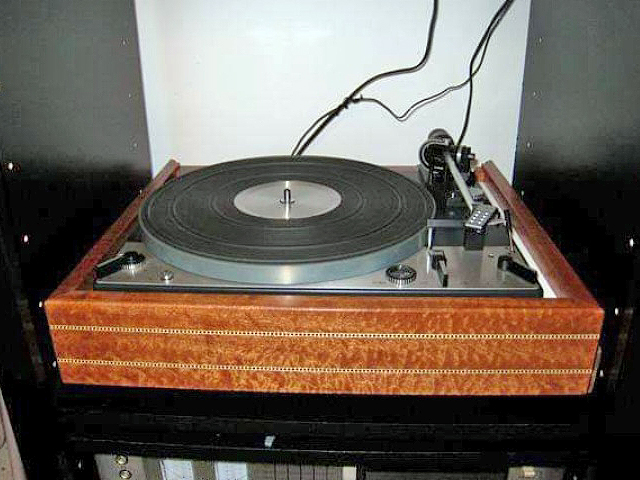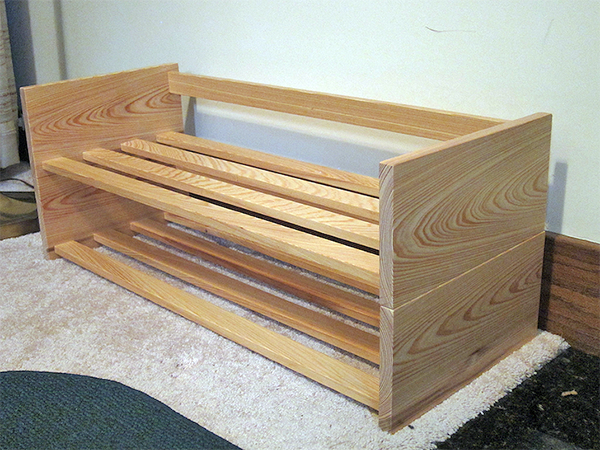
Last week, Rob asked for your thoughts about material choices for a shoe rack. Here are your recommendations. – Editor

“I have been reading your articles for years, and the shoe rack story was big in my house as well. I designed and built this shoe cabinet in our back hallway (see photo), and it has made a big difference.Thanks for all your tips and project ideas. By the way, the cabinet is plywood but the top is bird’s eye maple.” – Chris Goodness
“White oak. Spar varnish. Stands up to wet and shows the wood grain.” – Lee Axelson
“Have you considered using a clear epoxy on the rack? A thin layer of penetrating epoxy would form a durable bond and let the grain show through. You’ll either have to get very creative in the application process or epoxy the pieces first and then assemble. Or you could always spray five to six coats of a high quality Polycrylic™. I prefer the Polycrylic when spraying for the easy cleanup.” – Ken Weiss
“Making a shoe rack with plywood is a good idea, and since I like to see wood grain, I would choose a birch or maple plywood and use black stain followed up with polyurethane.” – Richard Smith
“Make it out of any wood you like but coat it with spar urethane to protect it from the sludge.” – Tom Smith

“My thoughts on your shoe rack come from my love of beautiful wood grains. Yes, you’re right — painted plywood makes sense. But if it were me, I would consider using 3/4” (perhaps maple or oak) dowel stock for the shoes to rest upon while building side panels and cubbies from something much nicer, such as pommele sapele or padauk. My favorite wood for small projects is pommele sapele, because it always ends up being a conversation piece. Here’s a turntable that I rebuilt for my brother a few years ago after he had accidently dropped it while bringing it in for repairs. I told him to get the mechanical workings repaired and I’d fix the rest.” – Ed De Mott
“Regarding the shoe rack, I know what you mean about choosing plywood. However, plywood is plain, boring, and cheap-looking. So, I think the solution is to make the bulk of it from plywood, but just as most of us do with plywood shelves, edge it with hardwood, match that same hardwood in some accent pieces, like trim around the panels or spots like that. I made quite a few of them in painted white semi-gloss paint with red oak touches. That red oak with the painted white is a nice offset.” – Tom Sherry
“You might consider PVC trim boards. Waterproof. Easy to machine. Can glue or pocket screw for wider boards. May even have some type of texture/wood grain to them. My son built some flower box planters a few years back from PVC trim boards. They’re holding up great — no rot!” – Ed Parry
“Man cave key here: Drip tray that slides out. Heated PVC uprights for wet boots to hang properly. Open oak shelves with alternating 1×2 material for free drainage. Maybe solid end with slats recessed into ends. Logo on ends of a bird hunt, maybe carved. Tung oil finish. You’ll have a man cave rack. Enjoy!” – Stephen England
“This may be heresy, but flooring stores now carry engineered wood flooring — real wood veneer with a durable coating, or fake wood flooring that has basically a picture of a piece of wood, also coated with a durable surface that is pretty much impenetrable. The side pieces could be real wood, with the shelves for the boots made out of the fake stuff. We have some of this flooring at our lake place, and with grandkids running in with sandy and wet feet all the time, it still looks good as new. And it really looks like wood. You might have to hang around some construction sites or befriend a contractor to obtain a couple of leftover pieces. Who knows what a six-pack toting visit might bring?” – Don Gwinn
“I’ve amassed a small amount of wood and MDF cabinet pieces from picking up furniture along the streets of my neighborhood. I usually break them down for storage and ‘cataloging.’ If I were to make something like a boot/shoe rack, I’d use some of the MDF. Paint is good. Some of the larger pieces, such as bookcases, have enough long pieces to serve as shelves, and at least they have a wood-grain look. As a side note, I’ve seen a lot of kneehole desks. For the life of me, I can’t figure why I’ve not seen any examples of a router table being made using one of these. Only thing they really need is an additional piece or two of MDF added to the top to make it flat and sturdy. They usually have four to six drawers, some of which are often deeper. Adding a dust-collection box would be simple enough. Casters can also be added without problem.” – Bob Steckbeck
“Four possibilities occur to me off the top of my head. 1) Use melamine-covered MDF or some plastic laminate for the shelf surfaces that the boots and shoes will be on and build the rest out of the wood of your choice. 2) Build it all out of the wood of your choice and coat the shelves with clear epoxy. 3) Find some small rubber floor mats, the type that have raised edges to contain the slop, and build the the cubicles to fit the mats. 4) Like option 3, find some inexpensive cookie sheets or maybe plastic storage tubs with most of the front panel cut out (leave a little lip to contain drips) to use as shelf inserts.” – Bill Koski
“Less is more. Less wood for more air when dripping and drying. Two rails per row with legs. Lesser finishing in the woodworking for practicality and so it will get used. Of course, the chosen finish or color must match the surroundings. Waterproof catch or liner on the bottom. One thin wipe-on coat of polyurethane on top of the wood to seal out the moisture? Paint is porous, yes? Shoe racks in the bedroom closets help, too.” – Tom Triola
“As you know, several coats of polyurethane will allow the wood grain to show and still protect the wood from the grime and moisture from the footwear. I have made outside Adirondack chairs from pine with several coats that have lasted years. I say, use whatever wood you’d like and poly it … maybe some teak or redwood?” – Rick Corbitt<
“If it were me, I’d make the rack from wood, have some protective sheets (with a lip) from plywood and finish with boat varnish that can be used for the outdoor shoes. Put them on the bottom shelf, angle those shelves slightly, with some drain holes/slots in the sheets (and a small reservoir or tray underneath them to protect the floor). This can be hidden by a faux kick panel.” – Colin Scowen
“My suggestion for the shoe rack is white oak covered with several coats of polyurethane.” – Dan Urban

“I’ve built several of these (pictured above) shoe racks that I designed. Even helped beginning woodworkers with making them. These are cypress, naturally weather resistant, finished with water-based polyurethane to preserve the lighter color of the wood. I’ve also used white oak, red oak and walnut to make additional ones for friends and neighbors who find the design useful. Assembly is quick, all with small pocket screws. They stack! I use (Festool) Domino slots in the top and bottom of each side piece. Insert a Domino to add a layer. You can adjust any level’s height, but I use the top shelf for boots and keep the lower shelf for shorter shoes. The slated bottom allows soles to dry; even on the lowest level there is 1/2″ of air circulation under the slats. Sides are all 5/8″ thickness, the slats are 1/2”. It maintains enough rigidity across about 3 ft. of length with no intermediate support.” – Allan Tuchman
“One option is to go to a restaurant supply store and buy plastic trays. Size the cubbies around them. Then the wood finish can be anything. Cleaning the cubbies is as simple as pulling out the trays and wiping them.” – James Dries






